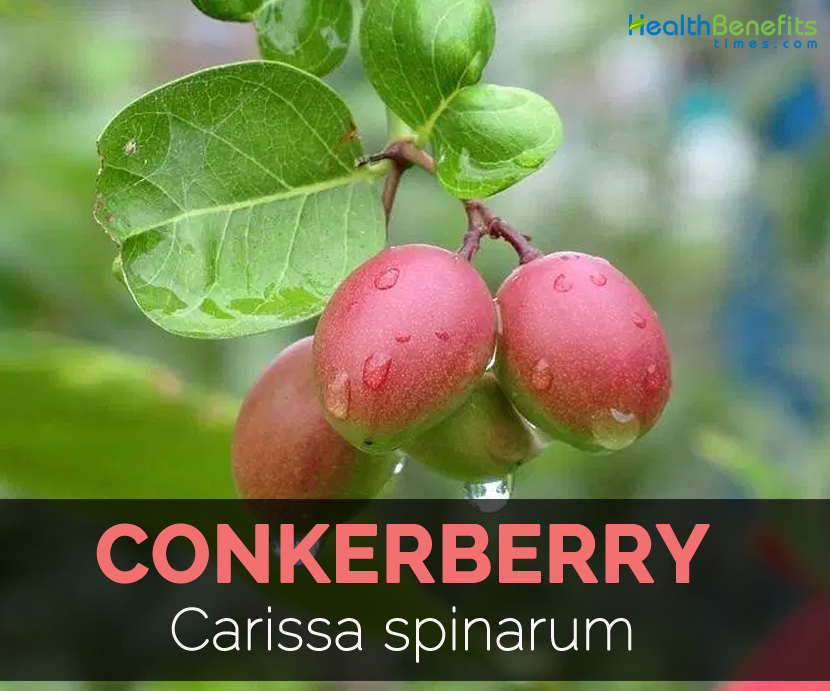| Conkerberry Quick Facts | |
|---|---|
| Name: | Conkerberry |
| Scientific Name: | Carissa spinarum |
| Origin | Common throughout much of India, Burma and dry areas of Ceylon. |
| Colors | White to pinky-white and pink turning blackish or reddish-purple |
| Shapes | Drupe, broadly ovoid or ellipsoid, 1.5–2.5 cm long |
| Flesh colors | Reddish-purple |
| Taste | Sour-sweet |
Conkerberry is a large shrub native and common throughout India, Burma and dry areas of Ceylon. The species got introduced to other countries in East Asia, Indonesia, Malaysia, South Vietnam, Cambodia and Philippines and to East Africa and the new world. It is grown as a multi-stemmed shrub measuring 0.5 to 3 meters high. Leaves are opposite, glossy green, narrow ovate to lanceolate about 1 to 5 cm long. Branches have thorns of 1-3 cm long. Flowers are followed by ovate green berries i.e. 1-2 cm long that turns black or dark purple when ripe.
Plant description
Conkerberry is a much branched, woody and climbing evergreen shrub that grows upto 5 meters high. Branches have sharp thorns which are simple or forked about 5 cm long found in pairs in leaf axils. Leaves are opposite, broadly ovate to oblong about 3-7 × 1.5-4 cm having broadly cuneate to rounded base, short apiculate apex and eight pairs of lateral veins. Leaves are leathery, dark green, glossy on upper surface and dull underside. Inflorescences are three flowered having fragrant flowers on 1.5-2.5 cm long peduncles having minute bracteoles. Calyx is 5-partite, synsepalous with very slender, pointed and hairy segments having basal glands inside. Corolla is 5-lobed, synetalous, salverform. Lobes are oblong lanceolate overlapping to the right, pubescent and corolla tube is cylindrical about 2 cm, white or pale rose. Pistil has an ellipsoid 2-carpelled, syncarpous ovary having 2 locules with axile placentation and 2 ovules in each locule. Flowers are then followed by a drupe which is broadly ovoid or ellipsoid measuring 1.5– 2.5 cm long, white to pinky-white and pink that turns blackish or reddish-purple and is bluntly pointed. It comprises of two to four small, flat and brown seeds in a reddish to purple pulp that tastes sour.
Nutritional value
The serving size of 100 grams of Ripe Conkerberry offers 745–753/kg (338–342/lb) calories, 83.17–83.24% moisture, 0.39–0.66% protein, 2.57–4.63% fat, 0.51–0.94% carbohydrate, 7.35–11.58% sugar, 0.62–1.81% fiber and 0.66– 0.78% ash. Additionally 9-11 mg of ascorbic acid content.
Traditional uses
- Use the unripe fruit for anorexia, diarrhea, as appetizer, thermogenic and constipating agent.
- It has a cooling effect and used as antidote for poisons and haemmatemesis.
- Ripe fruits are used for treating fever, sore throats, mouth ulcer, diarrhea, skin disorders, burning sensation.
- Leaf decoction is used for diarrhea, intermittent fever, soreness of mouth, throat, oral inflammation, earache and syphilitic pains.
- Roots are used as an aid for pyrexia, gonorrhea, chronic ulcer and indigestion.
- Boil the roots in decoction for aching bones.
- It is used as a cure for headache, rheumatism, chest complaints, rabies, syphilis, gonorrhea, malaria, herpes, edema, cough, toothache, worm infestation, ulcer, cough, jaundice, typhoid fever.
- It is also used to treat chickenpox.
- Fruits are used to manage dysentery.
- Apply the boiled leaves on gums to provide relief from toothache.
Culinary uses
- Fruits are consumed raw.
- Use it as a seasoning with curry, pies, puddings and tarts.
- Make pickle, chutney and preserves from unripe fruit.
- It is used in syrups and cold beverages.
- Use the ripe fruits to make wine.
- Dry it and eat like sultana.
Other facts
Burning the woods acts as a mosquito repellent.
References:
https://www.academia.edu/4792187/Carissa_spinarum_Our_Flora_formerly_Carissa_edulis_
http://www.nbrienvis.nic.in/WriteReadData/CMS/carissa%20spinrum.pdf
https://pdfs.semanticscholar.org/c271/b4dd580345e1ace8d0722b83f2cc072b71d5.pdf
https://www.cherneesutton.com.au/pages/conkerberry-bush
https://www.itis.gov/servlet/SingleRpt/SingleRpt?search_topic=TSN&search_value=30163#null
Comments
comments
